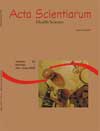A study of Li<sub>2</sub>CO<sub>3</sub> and C<sub>7</sub>H<sub>5</sub>NO<sub>3</sub>S noncaloric sweetener association in mice bone marrow cells
Abstract
This article presents the results of a research, project designed to evaluate the association of lithium carbonate and noncaloric sweetener in laboratory Swiss albino female mice, in a study phase using saccharin (Sc). The aim of this study was to evaluate significant differences as indicators of mutagenesis in treated mice groups. In nine tables, the micronucleus (MN) rate calculated in polychromatic erythrocytes (PCE) and normochromatic erythrocytes (NCE) was assessed. The animals were lithium orally treated for 10 days at the concentration of 100mg/kg or lithium treated in association with saccharin at the same concentration. The results were compared to groups treated with cyclophosphamide (Ci) (+) and water (-) - controls. Variance statistical analysis followed by Tukey’s test showed significant differences (p < 0.05) as for the mean MN rates in PCE and NCE and as for sum total with F= 16.57, 9.67 and F = 15.63 respectively. The by two comparison was analyzed by Student’s “t” test and significant differences were observed for Ci (+) group only. Considering the methodology used in female mice and the statistical analysis employed no mutagenesis indication was found MN frequency in bone marrow cells for this species.Downloads
Download data is not yet available.
Published
2008-07-17
How to Cite
Contar, J. de D. P., Santos, L. O. dos, Valim, S. B., & Guedes, T. A. (2008). A study of Li<sub>2</sub>CO<sub>3</sub> and C<sub>7</sub>H<sub>5</sub>NO<sub>3</sub>S noncaloric sweetener association in mice bone marrow cells. Acta Scientiarum. Health Sciences, 21, 403-408. https://doi.org/10.4025/actascihealthsci.v21i0.4454
Issue
Section
Health Sciences
DECLARATION OF ORIGINALITY AND COPYRIGHTS
I Declare that current article is original and has not been submitted for publication, in part or in whole, to any other national or international journal.
The copyrights belong exclusively to the authors. Published content is licensed under Creative Commons Attribution 4.0 (CC BY 4.0) guidelines, which allows sharing (copy and distribution of the material in any medium or format) and adaptation (remix, transform, and build upon the material) for any purpose, even commercially, under the terms of attribution.
Read this link for further information on how to use CC BY 4.0 properly.























5.png)







